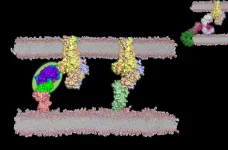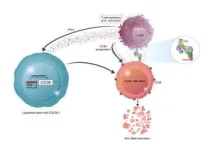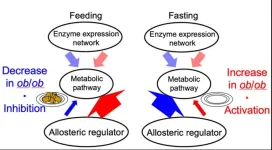(Press-News.org) FINDINGS
Scientists at City of Hope, one of the largest cancer research and treatment organizations in the United States, have devised an innovative approach to target and destroy hard-to-kill leukemia stem cells. The journal Blood published the preclinical findings today.
By overcoming challenges, such as drug resistance and treatment relapse common to patients with acute myeloid leukemia (AML), the therapy method could provide a less toxic and more effective approach for older and sicker patients who don’t quality for stem cell transplants — currently the only cure for AML available.
Type II interferon (IFNy), a substance produced by immune cells, disrupts the leukemia stem cells’ ability to divide and spread cancer. However, IFNy also stimulates CD38, a protein that suppresses the immune cells’ ability to mount a response against infection.
To overcome this challenge, the researchers designed a T cell engager antibody called CD38-BIONIC that creates a bridge between the T cells and the leukemia stem cells expressing CD38, enabling the immune system to kill off the cancer cells. Equally important, the approach did not damage healthy early blood stem cells or immune cells in human tissue or AML mouse models.
SIGNIFICANCE
When leukemia invades the bone marrow, it produces abnormal early blood cells called blasts that are CD38-positive. These divide rapidly and are easy to target. In contrast, the leukemia stem cells that form cancer stubbornly resist treatment and are CD38-negative.
“CD38 has successfully been exploited as a therapeutic target in multiple myeloma and other forms of leukemia,” said Flavia Pichiorri, Ph.D., M.S., who co-led the study with fellow investigators John Williams, Ph.D., and Guido Marcucci, M.D. — all professors at City of Hope. “Because AML stem cells are mainly CD38-negative, however, scientists have not prioritized CD38 as a therapeutic target for relapsed acute myeloid leukemia.”
In the current study, CD38-BIONIC binds to the CD38-positive blasts. This triggers the T cells to release IFNy, which converts the immature leukemia stem cells from CD38-negative to CD38-positive. In one stroke, the engineered antibody unmasks all the leukemia cells, exposing them to treatment.
“We believe that the compact format of BIONIC leads to an efficient immune system connection point with the CD38-positive blast, which drives IFNy production,” said Williams. “The leukemia stem cells react to the IFNy, painting themselves with CD38, which in turn allows them to be targeted by the CD38-CD3 BIONIC.”
Marcucci added, “This novel mechanism and the targeting by City of Hope’s homegrown approach will allow us to eliminate otherwise dormant leukemia stem cells. Our hope and goal is that eradication of leukemia stem cells will decrease and even eliminate the risk of disease relapse in patients with AML, but much more research needs to be done to translate our preclinical research into human treatment.”
BACKGROUND
Despite recent Food and Drug Administration-approved therapies, only 30% of adult patients with AML survive five years past diagnosis. More than half of patients relapse after treatment, and treatment resistance remains a major challenge. Patients often must remain hospitalized because their blood and immune systems are compromised by the cancer and its therapies.
While stem cell transplants from a bone marrow donor can prolong life, many older patients do not qualify due to their compromised health or the inability to find a matched donor. The majority of patients with AML urgently need less toxic and more effective treatments.
FUNDING
The research was partly supported by grants from the National Institutes of Health (R01-CA238429, R50-CA252135, P30CA033572), National Cancer Institute, Nason-Hollingsworth Project for Multiple Myeloma project and City of Hope’s Integrated Drug Development Venture program.
DISCLOSURE OF CONFLICT OF INTEREST
Co-authors Mariam Murtadha, Miso Park, Guido Marcucci, John C. Williams and Flavia Pichiorri are among the co-inventors on patent applications that cover certain inventions that are disclosed in this work. City of Hope is working to commercialize the technologies disclosed and claimed in these patent applications.
# # #
About City of Hope
City of Hope's mission is to make hope a reality for all touched by cancer and diabetes. Founded in 1913, City of Hope has grown into one of the largest cancer research and treatment organizations in the U.S. and one of the leading research centers for diabetes and other life-threatening illnesses. City of Hope research has been the basis for numerous breakthrough cancer medicines, as well as human synthetic insulin and monoclonal antibodies. With an independent, National Cancer Institute-designated comprehensive cancer center at its core, City of Hope brings a uniquely integrated model to patients spanning cancer care, research and development, academics and training, and innovation initiatives. City of Hope’s growing national system includes its Los Angeles campus, a network of clinical care locations across Southern California, a new cancer center in Orange County, California, and treatment facilities in Atlanta, Chicago and Phoenix. City of Hope’s affiliated group of organizations includes Translational Genomics Research Institute and AccessHopeTM. For more information about City of Hope, follow us on Facebook, X, YouTube, Instagram and LinkedIn.
END
NEWPORT NEWS, VA – Scientists are getting a more detailed look than ever before at the electrons they use in precision experiments.
Nuclear physicists with the U.S. Department of Energy’s Thomas Jefferson National Accelerator Facility have shattered a nearly 30-year-old record for the measurement of parallel spin within an electron beam – or electron beam polarimetry, for short. The achievement sets the stage for high-profile experiments at Jefferson Lab that could open the door to new physics discoveries.
In a peer-reviewed ...
FOR IMMEDIATE RELEASE, February 26, 2024
Contact: Gina DiGravio, 617-358-7838, ginad@bu.edu
BU Researchers Identify Potential New Subtype of Chronic Traumatic Encephalopathy
One in six cases have a distinct distribution of disease, clinical profile
(Boston)—Chronic traumatic encephalopathy (CTE) is a neurodegenerative disease defined by abnormal tau protein accumulating in a particular pattern in specific regions of the brain.
Studies to-date suggest CTE begins in the outermost layer of the frontal lobe, the neocortex, where it then spreads to connected brain regions. Later, in high-stage disease, ...
EMBARGOED by Cell until 11 am ET Feb. 26, 2024
Contact: Gina DiGravio, 617-358-7838, ginad@bu.edu
BU Researchers Describe New Technological Platform to
Accelerate Drug Development
(Boston)— Drug development is currently an extremely long, expensive and inefficient process. Findings generated in a lab are often very hard to replicate once translated into animal models or in humans.
A family of pharmacological targets, on which approximately 35% of FDA-approved drugs work, consists of receptors at the surface ...
One of the most striking examples of gut plasticity can be observed in animals that are exposed to prolonged periods of fasting, such as hibernating animals or phyton snakes that goes for months without eating, where the gut shrinks with as much as 50%, but recovers in size following a few days of re-feeding. Importantly, the capacity of the gut to undergo resizing is broadly conserved. Hence, in humans, an increase in gut size is observed during pregnancy, which facilitates the uptake of nutrients to support the growth of the fetus.
The Colombani Andersen ...
What if it were possible to use a scientific model to predict hate crimes, protests, or conflict? Researchers at McGill University and University of Toronto have begun the groundwork to develop a formal predictive model of prejudice, similar to meteorological weather predictions.
The model can be explained by the equation: Prejudice = Threat – Contact + Identification, “with some numbers involved,” says lead author Eric Hehman, Associate Professor in the Department of Psychology and lead author of a new study published in Psychological ...
Imagine a world where your smartphone can detect your mood just by the way you type a message or the tone of your voice. Picture a car that adjusts its music playlist based on your stress levels during rush hour traffic. These scenarios are not just futuristic fantasies. They are glimpses into the rapidly evolving field of affective computing. Affective computing is a multidisciplinary field integrating computer science, engineering, psychology, neuroscience and other related disciplines. A new and comprehensive review on affective computing was published Jan. 5 in Intelligent ...
AI decision-making is now common in self-driving cars, patient diagnosis and legal consultation, and it needs to be safe and trustworthy. Researchers have been trying to demystify complex AI models by developing interpretable and transparent models, collectively known as explainable AI methods or XAI methods. A research team offered their insight specifically into audio XAI models in a review article published Jan. 23 in Intelligent Computing, a Science Partner Journal.
Although audio tasks are less researched than visual tasks, their expressive power is not less important. Audio signals are easy to understand and communicate, as they typically depend less on expert explanations ...
JMIR Publications is pleased to announce a new theme issue in JMIR Neurotechnology exploring brain-computer interfaces (BCIs) that represent the transformative convergence of neuroscience, engineering, and technology. The peer-reviewed journal aims to bridge the gap between clinical neuroscience and information technology by providing a platform for applied human research in the field of neurology.
JMIR Neurotechnology welcomes submissions from scientists, clinicians, and technologists. PhD students and early career researchers are ...
Your liver plays a vital role in your metabolism, the biological process which converts food into energy. We know that being overweight can negatively affect metabolic activity, but not exactly how. To better understand this, researchers compared the livers of mice which were a typical weight with mice which were obese. They were surprised to find that biological regulation of metabolic activity, after a period of feasting and fasting, was reversed between them. In typical mice, allosteric regulation (the process which controls metabolism) was inhibited during feeding and activated when fasting. However, ...
Striped marlin are some of the fastest animals on the planet and one of the ocean’s top predators. When hunting in groups, individual marlin will take turns attacking schools of prey fish one at a time. Now a new study reported in the journal Current Biology on February 5 helps to explain how they might coordinate this turn-taking style of attack on their prey to avoid injuring each other. The key, according to the new work, is rapid color changes.
“We documented for the first time rapid color change in a group-hunting predator, the striped marlin, as groups of marlin hunted schools of sardines,” says Alicia Burns of Humboldt University ...






